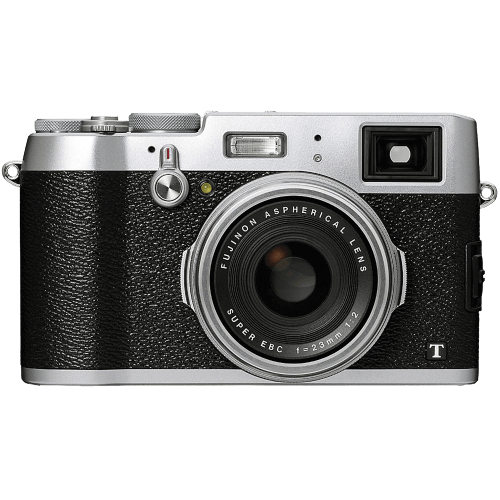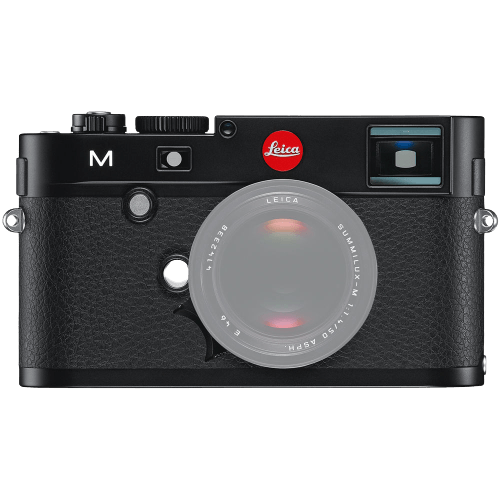Fujifilm X100T vs Leica M Typ 240 Comparison
Fujifilm X100T

Leica M Typ 240

The Leica M Typ 240 wins with a score of 57/100, compared to the Fujifilm X100T‘s 53/100. Both cameras are mirrorless and share similarities in size and weight. The Fujifilm X100T measures 127 x 74 x 52mm and weighs 440g, while the Leica M Typ 240 comes in at 139 x 80 x 42mm and 680g.
The Leica M Typ 240 has a higher score, indicating that it is a better camera overall. However, the Fujifilm X100T has its advantages, such as being lighter and more affordable, with a launch price of $1300 compared to the Leica’s $6950.
Although the Leica M Typ 240 is the winner, both cameras have their merits, and the choice depends on individual preferences and budget.
Fujifilm X100T vs Leica M Typ 240 Overview and Optics
The Leica M Typ 240 comes out ahead in the optics comparison, scoring 62/100, while the Fujifilm X100T scores 54/100. Both cameras share some common specifications, such as having a CMOS sensor, no image stabilization, and similar processors ��� EXR Processor II for the Fujifilm and Maestro for the Leica.
The Leica M Typ 240 outperforms the Fujifilm X100T in a few key areas. Firstly, it has a higher megapixel count of 24, compared to the Fujifilm’s 16. This allows for more detailed and higher-resolution images. Additionally, the Leica M Typ 240 has a full-frame sensor, which is larger than the APS-C sensor of the Fujifilm X100T. A larger sensor typically results in better image quality, especially in low light situations. The Leica M Typ 240 also has a DXOMARK sensor score of 84, while the Fujifilm X100T does not have a DXOMARK score. Lastly, the Leica M Typ 240 has a lens mount, allowing for interchangeable lenses, while the Fujifilm X100T has a fixed lens mount.
On the other hand, the Fujifilm X100T has a faster shooting speed of 6 frames per second, compared to the Leica M Typ 240’s 3 frames per second. This can be advantageous in capturing fast-moving subjects or action shots.
Taking these factors into account, the Leica M Typ 240 offers better image quality and versatility due to its higher megapixel count, larger sensor size, and interchangeable lens system. However, the Fujifilm X100T provides a faster shooting speed, which can be beneficial for some photographers. Ultimately, the choice between these two cameras will depend on the specific needs and preferences of the user.
Fujifilm X100T vs Leica M Typ 240 Video Performance
The Fujifilm X100T outperforms the Leica M Typ 240 in video capabilities, scoring 70/100 compared to the Leica’s 43/100. Both cameras share some common specifications, such as Full HD maximum video resolution and 1920×1080 maximum video dimensions. However, the Fujifilm X100T offers superior features that contribute to its higher score.
The Fujifilm X100T has an advantage in video frame rate, offering a maximum of 60fps, whereas the Leica M Typ 240 only reaches 30fps. This higher frame rate allows for smoother video playback and more flexibility during post-processing, such as creating slow-motion footage. Additionally, the Fujifilm X100T has built-in time-lapse functionality, which the Leica M Typ 240 lacks. This feature enables users to create unique time-lapse videos without the need for additional equipment or software.
Although the Leica M Typ 240 falls short in comparison to the Fujifilm X100T, it still maintains Full HD video resolution and 1920×1080 video dimensions, providing decent video quality for casual users. However, its lower video score reflects the limitations in frame rate and the absence of built-in time-lapse functionality.
Taking all factors into consideration, the Fujifilm X100T is the superior option for video capabilities, thanks to its higher frame rate and built-in time-lapse feature. While the Leica M Typ 240 still offers acceptable video quality, its limitations make it less versatile and less suitable for those prioritizing video performance.
Fujifilm X100T vs Leica M Typ 240 Features and Benefits
The Fujifilm X100T outperforms the Leica M Typ 240 in terms of features, scoring 58 out of 100, while the Leica M Typ 240 scores 54. Both cameras share some common specifications. They both have a 3-inch screen size and lack a touchscreen and GPS.
The Fujifilm X100T has several advantages over the Leica M Typ 240. Its screen resolution is significantly higher, with 2,360,000 dots compared to the Leica’s 920,000 dots. This results in a sharper and clearer display for the Fujifilm X100T. Additionally, the X100T has a flip screen, offering more flexibility when composing shots. The presence of Wi-Fi and Bluetooth connectivity in the X100T further enhances its functionality, allowing for easy sharing and remote control of the camera.
The Leica M Typ 240, on the other hand, has limited advantages over the Fujifilm X100T. It does not have a flip screen, Wi-Fi, or Bluetooth connectivity. These missing features make the Leica M Typ 240 less versatile and user-friendly compared to the Fujifilm X100T.
In terms of features, the Fujifilm X100T is the clear winner. Its higher screen resolution, flip screen, and connectivity options provide a better user experience and more flexibility when capturing photos. On the contrary, the Leica M Typ 240 falls short in features, making it less competitive in comparison to the Fujifilm X100T.
Fujifilm X100T vs Leica M Typ 240 Storage and Battery
The Leica M Typ 240 triumphs over the Fujifilm X100T in the storage and battery category with a score of 27/100, while the Fujifilm X100T scores 21/100. Both cameras share similarities in their storage capabilities, as they both have a single memory card slot and accept SD, SDHC, and SDXC cards. However, the Leica M Typ 240 stands out in battery performance, offering a longer battery life of 500 shots compared to the Fujifilm X100T’s 330 shots, using the BP-SCL2 battery type.
Despite its lower score, the Fujifilm X100T still performs well with its Lithium-Ion NP-95 battery, though it falls short in comparison to the Leica M Typ 240’s endurance. Neither camera offers USB charging capabilities.
Considering these factors, the Leica M Typ 240 proves to be superior in terms of storage and battery life, providing users with a longer-lasting experience. The Fujifilm X100T remains a decent option, but those seeking extended battery life may find the Leica M Typ 240 more suitable.
Fujifilm X100T vs Leica M Typ 240 – Our Verdict
Are you still undecided about which camera is right for you? Have a look at these popular comparisons that feature the Fujifilm X100T or the Leica M Typ 240:

